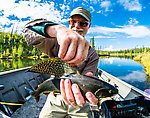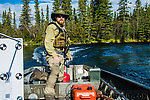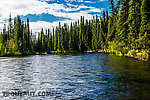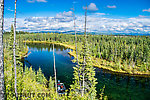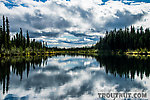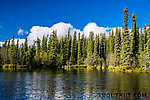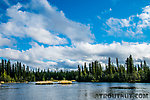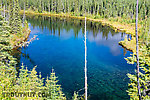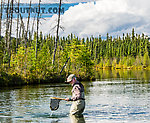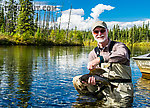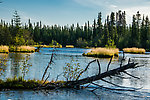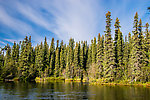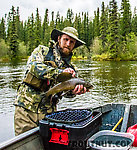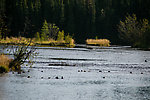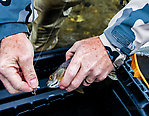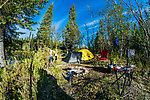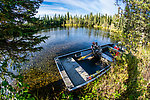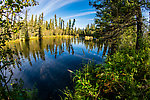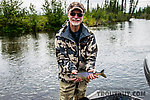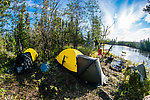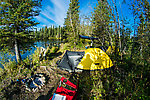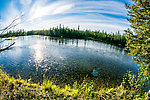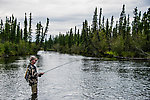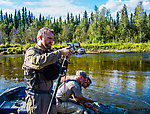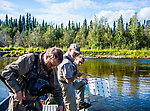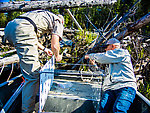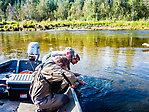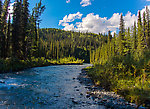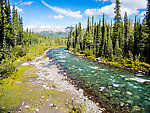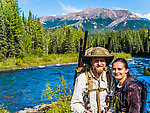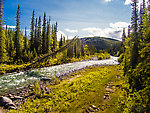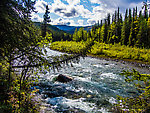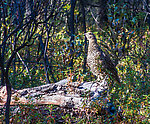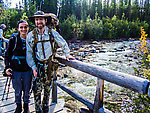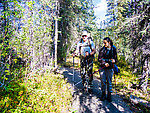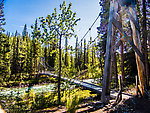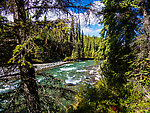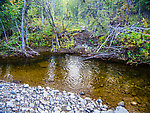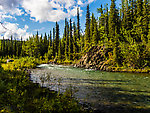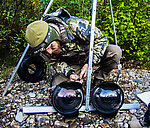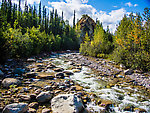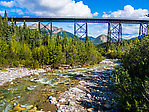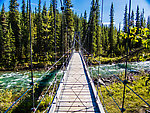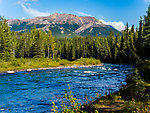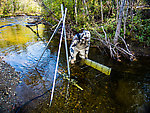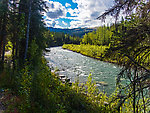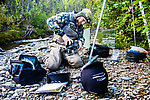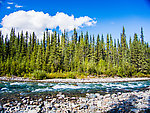Blog & Latest Updates
Fly Fishing Articles
Insects by Common Name


Latest updates, page 32
Wilderness Grayling - Day 2
Morning broke clear, cool, and calm. After arranging some dry kindling I had placed in my vestibule the night before, I used some flammable “spruce goo” (the sticky sap that leaks out onto the bark of wounded spruce trees) to ignite a campfire, then heated water for coffee so I could warm myself inside and out. I stared into the fire while reveling in my new-found freedom (retirement), luxuriating in the aroma of wood smoke and sipping hot coffee as the Sun broke over the horizon. From my perspective, this campsite – circumscribed by a sparkling stream and its spires of riparian spruce – was more tranquil and spiritually nurturing than any manmade cathedral. In places like this, the competitive pursuits of men appear trivial, and all is governed by natural law. There is no blame and no forgiveness – only a beautiful and unbiased reality that demands both appreciation and respect.

Our hen pintail was back again this morning, feeding over shallow gravel across from camp. I wish I knew what attracted her, and only her, to this spot. By 10:30 a.m. we were organized for a final day of work on the river. Jason jet-motored our Jon boat full of sampling gear upstream to find the best spot to film grayling and catch them with fly-fishing gear to see what they’d been eating.
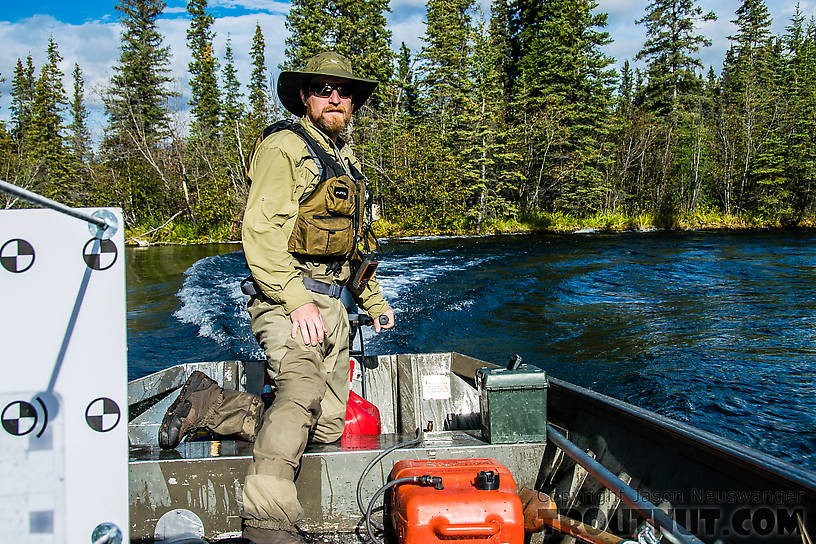
We carefully scouted the next mile of river, peering into the crystal clear water with polarized sunglasses to see where grayling were either milling about in large groups or drift-feeding in semi-stationary positions. Finally we stopped at a deep run that had a good number of non-transient fish, and more importantly, fish we might be able to film with near-shore underwater camera gear.
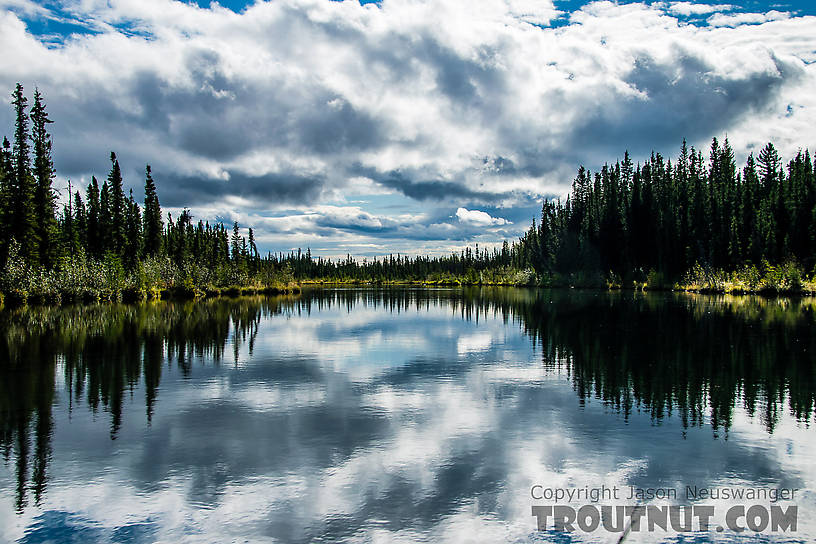
Climbing a steep slope on the right ascending bank through dense shrubs and small trees regenerating after a recent wildfire, we were treated to a breathtaking view of our study site and the wilderness beyond. By Noon we were setting up to work here.
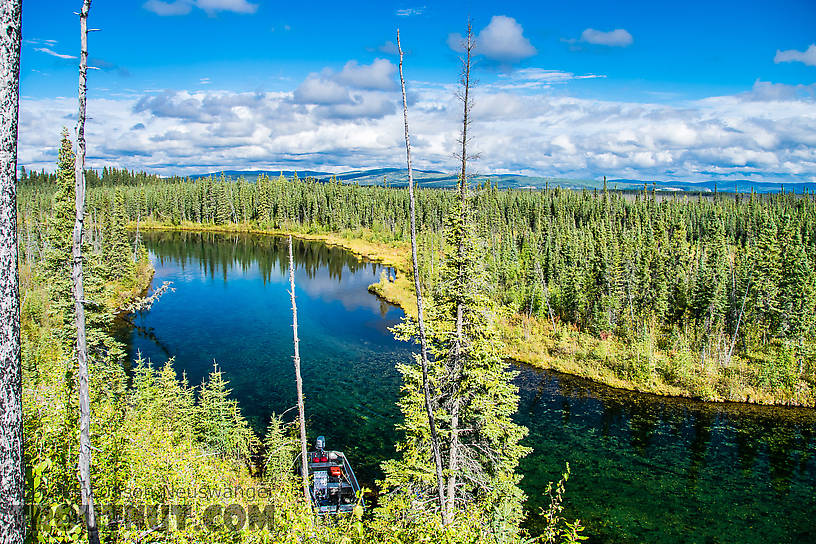
By mid-afternoon we had completed our drift-net sampling, velocity calibrations, and video recording of drift-feeding fish, so we began fly-fishing in the same location in order to capture fish for diet analysis.
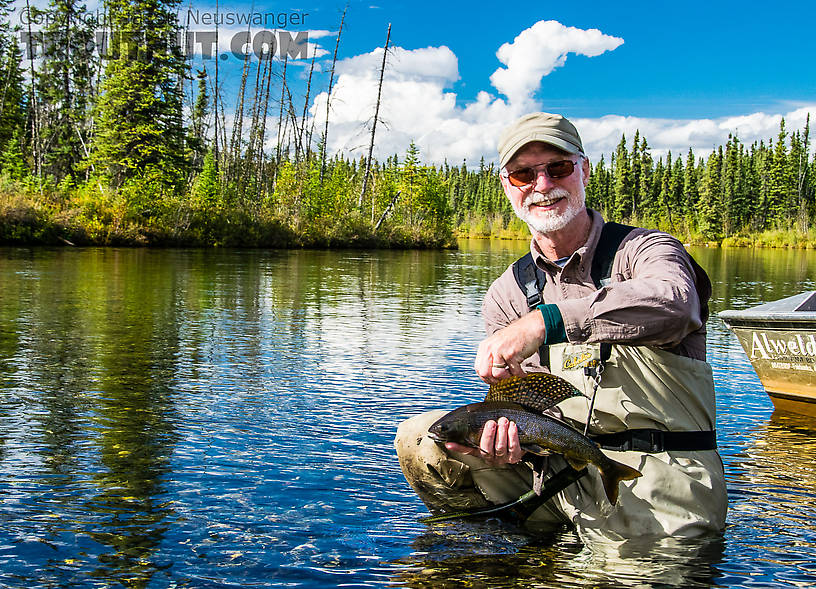
Among other things, Jason hopes to learn whether grayling feed selectively or eat small items of prey in proportion to their appearance in the drift-net samples. Once again, the discovery of large numbers of caddis fly larvae still in their tiny gravel cases revealed that these fish can forego drift-feeding to become active benthic grazers. Video footage of benthic feeding corroborated this conclusion, and at the same time reminded us to interpret diet data cautiously. The cased caddis larvae were visibly crawling around on the bottom, frequently losing their grip and drifting a few cobbles downstream. Some of the larvae in grayling stomachs were probably captured during these drifts, too. Hmmm… I wonder if this is what all those ducks were eating this morning near camp?

By late afternoon we had accomplished the sampling mission, so we returned to camp and spent (Spent: The wing position of many aquatic insects when they fall on the water after mating. The wings of both sides lay flat on the water. The word may be used to describe insects with their wings in that position, as well as the position itself.) the next couple hours packing up. The boat ride down the study stream and back up the Tanana was uneventful, but loading out back at the landing was another matter. Unknown to us, the right standard intended to guide the borrowed boat onto its trailer was not firmly bolted to the trailer frame. I guided the boat full of gear onto the trailer without incident in the mild current of the creek, but when Jason started to tow the heavy load out, current and vibration pushed the boat over the right standard. I yelled, “Whoa!” to Jason as I watched the mishap unfold, but the boat had already crashed off the right side of the trailer at a precarious angle with the stern almost underwater and the bow still connected to the trailer winch. We had no choice but to unload everything at the muddy shoreline, push the boat back out into the river, realign and tighten the right standard, reload the boat, and then load all our gear either back into the boat or into the back of Jason’s RAV4. This was not how we had planned to end an already long day, but we got it done and were able to tow the boat up the steep ramp after I showed Jason how to align the vehicle and trailer at angles to one another in order to develop early momentum and power to pull. Fortunately there was nobody at the boat ramp to witness the debacle.

Our hen pintail was back again this morning, feeding over shallow gravel across from camp. I wish I knew what attracted her, and only her, to this spot. By 10:30 a.m. we were organized for a final day of work on the river. Jason jet-motored our Jon boat full of sampling gear upstream to find the best spot to film grayling and catch them with fly-fishing gear to see what they’d been eating.

We carefully scouted the next mile of river, peering into the crystal clear water with polarized sunglasses to see where grayling were either milling about in large groups or drift-feeding in semi-stationary positions. Finally we stopped at a deep run that had a good number of non-transient fish, and more importantly, fish we might be able to film with near-shore underwater camera gear.

Climbing a steep slope on the right ascending bank through dense shrubs and small trees regenerating after a recent wildfire, we were treated to a breathtaking view of our study site and the wilderness beyond. By Noon we were setting up to work here.

By mid-afternoon we had completed our drift-net sampling, velocity calibrations, and video recording of drift-feeding fish, so we began fly-fishing in the same location in order to capture fish for diet analysis.

Among other things, Jason hopes to learn whether grayling feed selectively or eat small items of prey in proportion to their appearance in the drift-net samples. Once again, the discovery of large numbers of caddis fly larvae still in their tiny gravel cases revealed that these fish can forego drift-feeding to become active benthic grazers. Video footage of benthic feeding corroborated this conclusion, and at the same time reminded us to interpret diet data cautiously. The cased caddis larvae were visibly crawling around on the bottom, frequently losing their grip and drifting a few cobbles downstream. Some of the larvae in grayling stomachs were probably captured during these drifts, too. Hmmm… I wonder if this is what all those ducks were eating this morning near camp?

By late afternoon we had accomplished the sampling mission, so we returned to camp and spent (Spent: The wing position of many aquatic insects when they fall on the water after mating. The wings of both sides lay flat on the water. The word may be used to describe insects with their wings in that position, as well as the position itself.) the next couple hours packing up. The boat ride down the study stream and back up the Tanana was uneventful, but loading out back at the landing was another matter. Unknown to us, the right standard intended to guide the borrowed boat onto its trailer was not firmly bolted to the trailer frame. I guided the boat full of gear onto the trailer without incident in the mild current of the creek, but when Jason started to tow the heavy load out, current and vibration pushed the boat over the right standard. I yelled, “Whoa!” to Jason as I watched the mishap unfold, but the boat had already crashed off the right side of the trailer at a precarious angle with the stern almost underwater and the bow still connected to the trailer winch. We had no choice but to unload everything at the muddy shoreline, push the boat back out into the river, realign and tighten the right standard, reload the boat, and then load all our gear either back into the boat or into the back of Jason’s RAV4. This was not how we had planned to end an already long day, but we got it done and were able to tow the boat up the steep ramp after I showed Jason how to align the vehicle and trailer at angles to one another in order to develop early momentum and power to pull. Fortunately there was nobody at the boat ramp to witness the debacle.
Photos by Troutnut from Mystery Creek #186 in Alaska
Wilderness Grayling - Day 1
I arose before Jason and staggered out into the cool damp morning to discover that light rain overnight had left only a few smoldering embers in an otherwise soggy fire pit. Everything, including all potential kindling, was damp. The weather looked promising as the sun ascended into the clear blue southeastern sky, so we decided to forego a morning fire and simply heat water for coffee and granola. Jason took many photos this morning, but they did not capture the pristine crispness of the sub-arctic air; nor did they convey the quiet tranquility that reigns over this remote place.

Interrupted only by the rare vocalizations of ravens and ducks, the river gurgled around our peninsular campsite, caring not one whit about the comings and goings of men. Awareness of humanity’s relatively insignificant role in the natural cycle of life is one of the gifts of wilderness travel.
As I was filtering river water to fill our 3-liter bags and 1-liter bottles, a lone hen pintail sailed into the slack water on the far side of our wide bend in the river and spent (Spent: The wing position of many aquatic insects when they fall on the water after mating. The wings of both sides lay flat on the water. The word may be used to describe insects with their wings in that position, as well as the position itself.) the mid-morning hours feeding on some type of invertebrate. There were no plants growing in the shallow gravel where she fed. A pair of hen widgeon puddled around in similar spots near the far shore, also feeding on something non-vegetative. Upstream about 200 yards, a flock of 20-25 puddle ducks (probably widgeon and a few mallards) were also feeding on something besides plants in a relatively shallow, slack-water area near shore. Water temperature in this crystal clear, gravel-bottomed river was only 40F. I wish we knew what kind of non-vegetative food all these puddle ducks were eating.
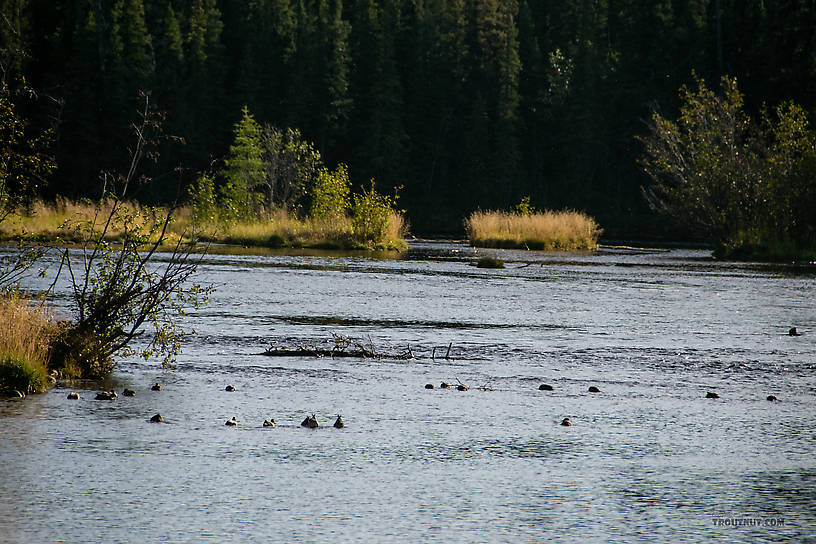
By mid-morning we were preparing for a day of field-testing equipment and procedures. I assembled the camera calibration frame and made other preparations while Jason checked batteries, camera settings, and underwater housings. By 10:00 a.m. we were in our chest waders and exploring the river near camp, running logistical tests on drift-net deployment, current velocity measurement, positioning of the modified camera array tripod to film drift-feeding grayling, and anaesthetizing fish Jason caught on his fly rod so we could remove their stomach contents by gastric lavage. The drift-net quickly filled with tiny particles of debris, convincing Jason that mesh size needed to be larger. Water-soaked grains of cous cous acquired near-neutral buoyancy and worked better than tapioca balls as tracers to monitor current velocity by underwater video. The modified tripod worked much better than at Mystery Creek #170. And grayling were suitably calmed after spending a minute or so in a dilute solution of sparkling water with high carbon dioxide concentration, allowing us to pump, filter, and preserve stomach contents before releasing the fish unharmed near their point of capture.
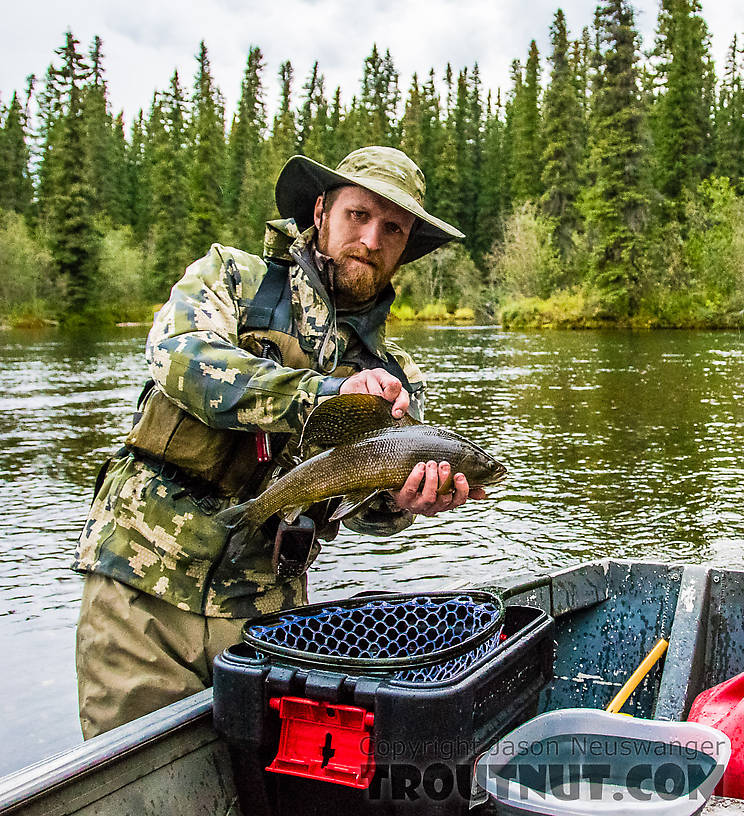
By late afternoon we were ready to explore other reaches upstream that might hold promise for filming and capturing drift-feeding grayling. Just before departing from camp, a jet boat rounded our peninsula heading upstream, piloted by a serious-looking, gray-bearded fellow who fit the archetypal appearance of the grizzled sourdoughs who built Alaska. When we traveled upstream ourselves, we found it necessary to disturb him momentarily by motoring past the spot he had stopped to fish near the mouth of a small tributary; but we executed our intrusion as respectfully as possible. Not long after we had arrived at a place Jason had scouted previously, the old-timer (I should talk) motored up from below, anchored, and began fishing just downstream of us. I did not know what to make of this, because there were lots of places to fish that were not immediately adjacent to the only other boat on the river. Soon he called out, “Are you guys packing?” I thought it was an odd first question, and, having been warned about the territoriality of a few of the area’s residents, I was not sure whether it was even wise to respond to such an inquiry. Jason told him we were not carrying firearms at the moment.
At this point our new companion’s good intentions became clear, as he alerted us that two large boar grizzlies had been hunting moose in the area all summer. Just a few days earlier, he had watched one of them fighting a large cow moose in the river just upstream of our current location. Of course, we appreciated the “heads-up” and took proper precautions the next day. The gentleman turned out to be a highly educated, well-spoken professional from Fairbanks, who typically worked short weeks from Monday to Thursday, then spent (Spent: The wing position of many aquatic insects when they fall on the water after mating. The wings of both sides lay flat on the water. The word may be used to describe insects with their wings in that position, as well as the position itself.) long weekends in a cabin on the river. Jason learned a lot from him about the river and its history, and was happy to have a local contact for information on water levels and other conditions that might affect future sampling trips. To reiterate an old adage, “You can’t judge a book by its cover.”
Our friend headed back downstream at ~5:00 p.m., so we waded into a good-looking run nearby and started catching chunky grayling 15-17 inches long. On a 5-weight fly rod in moderate current, they exhibited the strength and endurance of premier sport fish like rainbow trout and smallmouth bass.
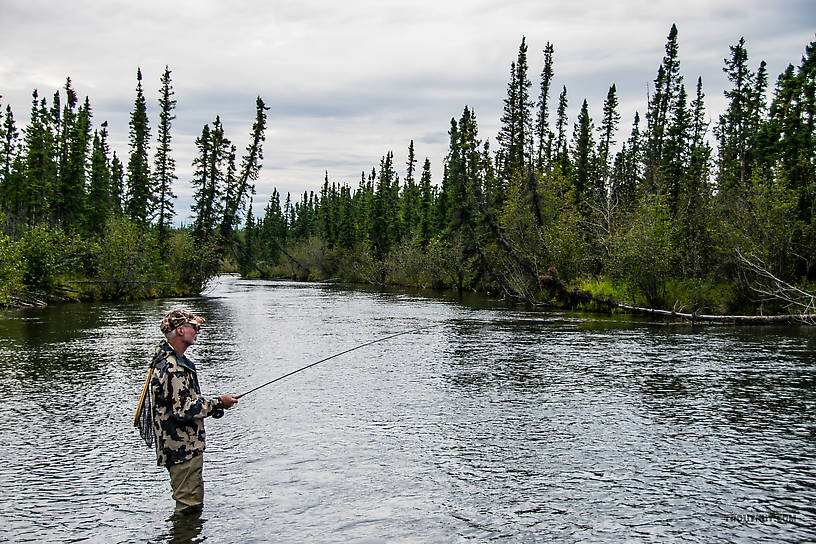
For the next hour or two, we enjoyed outstanding Arctic grayling fishing in a wilderness setting, interrupted only by the need to pump the stomach contents of several specimens. One or more species of caddis fly larvae still in their small-pebble cases dominated the diet, indicating that grayling were not only drift-feeding, but also grazing on the gravel substrate.
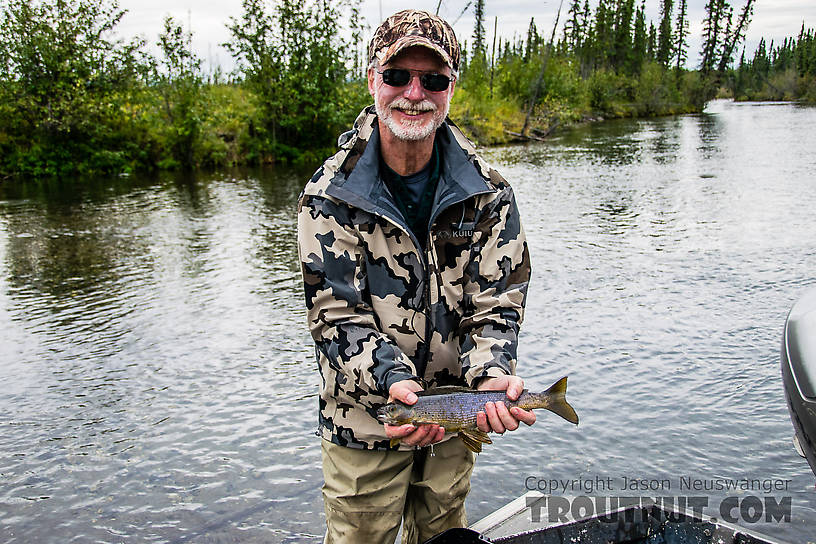
To reiterate a question that has been posed to me occasionally over my 35-year career in fishery management, “How do I get a job like this?”
We called it a day at about 9:00 p.m. and motored back downstream to camp shortly before dark. The day had been warm and sunny, so we had ample dry kindling to start a fire. We enjoyed a relaxing, if short, evening around the campfire eating our Mountain House meals and planning for tomorrow before crawling into our sleeping bags as the calm chill of a Northern night fell upon us. It had been an interesting and productive day.

Interrupted only by the rare vocalizations of ravens and ducks, the river gurgled around our peninsular campsite, caring not one whit about the comings and goings of men. Awareness of humanity’s relatively insignificant role in the natural cycle of life is one of the gifts of wilderness travel.
As I was filtering river water to fill our 3-liter bags and 1-liter bottles, a lone hen pintail sailed into the slack water on the far side of our wide bend in the river and spent (Spent: The wing position of many aquatic insects when they fall on the water after mating. The wings of both sides lay flat on the water. The word may be used to describe insects with their wings in that position, as well as the position itself.) the mid-morning hours feeding on some type of invertebrate. There were no plants growing in the shallow gravel where she fed. A pair of hen widgeon puddled around in similar spots near the far shore, also feeding on something non-vegetative. Upstream about 200 yards, a flock of 20-25 puddle ducks (probably widgeon and a few mallards) were also feeding on something besides plants in a relatively shallow, slack-water area near shore. Water temperature in this crystal clear, gravel-bottomed river was only 40F. I wish we knew what kind of non-vegetative food all these puddle ducks were eating.

By mid-morning we were preparing for a day of field-testing equipment and procedures. I assembled the camera calibration frame and made other preparations while Jason checked batteries, camera settings, and underwater housings. By 10:00 a.m. we were in our chest waders and exploring the river near camp, running logistical tests on drift-net deployment, current velocity measurement, positioning of the modified camera array tripod to film drift-feeding grayling, and anaesthetizing fish Jason caught on his fly rod so we could remove their stomach contents by gastric lavage. The drift-net quickly filled with tiny particles of debris, convincing Jason that mesh size needed to be larger. Water-soaked grains of cous cous acquired near-neutral buoyancy and worked better than tapioca balls as tracers to monitor current velocity by underwater video. The modified tripod worked much better than at Mystery Creek #170. And grayling were suitably calmed after spending a minute or so in a dilute solution of sparkling water with high carbon dioxide concentration, allowing us to pump, filter, and preserve stomach contents before releasing the fish unharmed near their point of capture.

By late afternoon we were ready to explore other reaches upstream that might hold promise for filming and capturing drift-feeding grayling. Just before departing from camp, a jet boat rounded our peninsula heading upstream, piloted by a serious-looking, gray-bearded fellow who fit the archetypal appearance of the grizzled sourdoughs who built Alaska. When we traveled upstream ourselves, we found it necessary to disturb him momentarily by motoring past the spot he had stopped to fish near the mouth of a small tributary; but we executed our intrusion as respectfully as possible. Not long after we had arrived at a place Jason had scouted previously, the old-timer (I should talk) motored up from below, anchored, and began fishing just downstream of us. I did not know what to make of this, because there were lots of places to fish that were not immediately adjacent to the only other boat on the river. Soon he called out, “Are you guys packing?” I thought it was an odd first question, and, having been warned about the territoriality of a few of the area’s residents, I was not sure whether it was even wise to respond to such an inquiry. Jason told him we were not carrying firearms at the moment.
At this point our new companion’s good intentions became clear, as he alerted us that two large boar grizzlies had been hunting moose in the area all summer. Just a few days earlier, he had watched one of them fighting a large cow moose in the river just upstream of our current location. Of course, we appreciated the “heads-up” and took proper precautions the next day. The gentleman turned out to be a highly educated, well-spoken professional from Fairbanks, who typically worked short weeks from Monday to Thursday, then spent (Spent: The wing position of many aquatic insects when they fall on the water after mating. The wings of both sides lay flat on the water. The word may be used to describe insects with their wings in that position, as well as the position itself.) long weekends in a cabin on the river. Jason learned a lot from him about the river and its history, and was happy to have a local contact for information on water levels and other conditions that might affect future sampling trips. To reiterate an old adage, “You can’t judge a book by its cover.”
Our friend headed back downstream at ~5:00 p.m., so we waded into a good-looking run nearby and started catching chunky grayling 15-17 inches long. On a 5-weight fly rod in moderate current, they exhibited the strength and endurance of premier sport fish like rainbow trout and smallmouth bass.

For the next hour or two, we enjoyed outstanding Arctic grayling fishing in a wilderness setting, interrupted only by the need to pump the stomach contents of several specimens. One or more species of caddis fly larvae still in their small-pebble cases dominated the diet, indicating that grayling were not only drift-feeding, but also grazing on the gravel substrate.

To reiterate a question that has been posed to me occasionally over my 35-year career in fishery management, “How do I get a job like this?”
We called it a day at about 9:00 p.m. and motored back downstream to camp shortly before dark. The day had been warm and sunny, so we had ample dry kindling to start a fire. We enjoyed a relaxing, if short, evening around the campfire eating our Mountain House meals and planning for tomorrow before crawling into our sleeping bags as the calm chill of a Northern night fell upon us. It had been an interesting and productive day.
Photos by Troutnut from Mystery Creek #186 in Alaska
Establishing Base Camp at Grayling Study Stream
Jason and I spent (Spent: The wing position of many aquatic insects when they fall on the water after mating. The wings of both sides lay flat on the water. The word may be used to describe insects with their wings in that position, as well as the position itself.) the day organizing and packing gear needed to camp and work on a large, clear, entirely spring-fed river southeast of Fairbanks. At ~6:30 p.m. we arrived at a mud/gravel boat landing and parking area loaded with the vacated rigs of opening-day moose hunters accessing the Tanana River – their highway into the bush. As we donned our waders and prepared to launch the boat, I heard, then saw, my first peregrine falcons. Their nest was high on a cliff opposite the boat landing, but we did not see them until the pair did a “fly-by” overhead. Magnificent birds.
Skies were mostly clear and the sun was bright as we exited the launch area and headed down the Tanana River with the current against a mild westerly breeze.
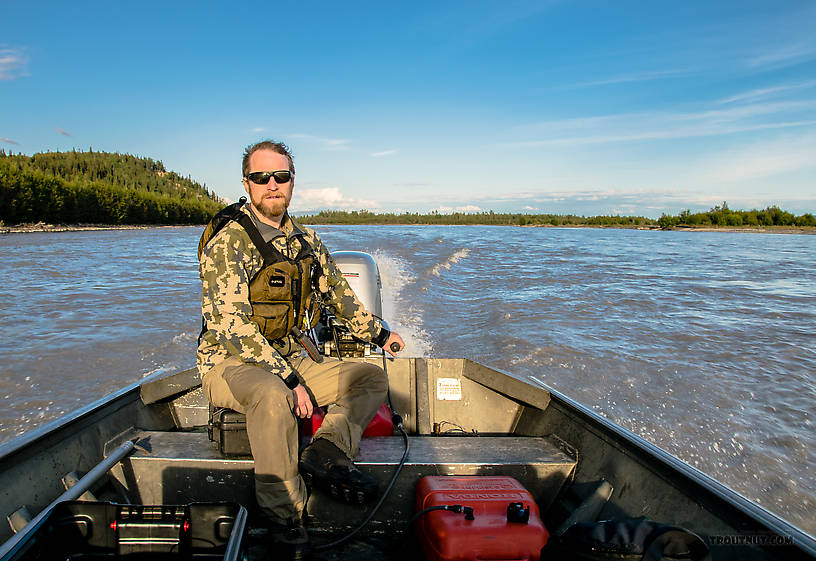
Snow-capped peaks of the Alaska Range could be seen low on the horizon to our southeast.

The old Honda jet outboard motor expressed frequent disagreement with us about which gear it should be in, slipping from forward into neutral at the most inopportune, high-speed moments and showering Jason with cold water every few minutes. Jason navigated westward through a labyrinth of islands in the wide, shallow slurry of gray glacial melt-water. It took approximately half an hour to travel downstream to the mouth of the study stream, which was well concealed by various islands and sloughs. Within a minute, water clarity went from zero to infinity as we headed up the tributary to Jason’s study site.
In the lower couple miles we passed numerous cabins of various design, from makeshift shacks covered by rusty corrugated metal to modern log homes powered by solar energy. The only common theme among these dwellings was the obligatory pair of moose or caribou antlers adorning the front entrance, and the fact that most material had been transported here, piece by piece, after a boat ride down the Tanana. You really have to want to “get away” to maintain a residence here.
The jet motor was essential as we navigated upstream through riffles barely 6 inches deep, manually coaxing the motor to stay in gear and “up on step” through the shallows. A couple large broods of almost fully grown common mergansers calmly observed our passing from their perches atop logs lain across the surface near shore. Once we passed all the private cabins, we would search for a good site to establish base camp in the vicinity of runs or pools where Arctic grayling could be filmed and captured; but good campsites along the dense riparian corridor were few and far between.
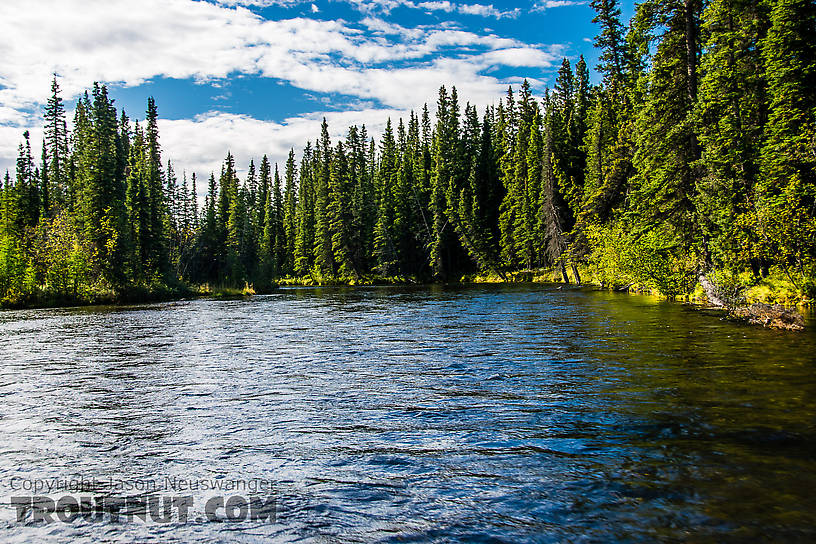
After traveling several miles upriver and beyond the last of the cabins, I began to feel that we were burning valuable daylight. Finally we arrived at a sharp bend where the river widened considerably and the tip of the peninsula on the inside of the bend held promise as a campsite. Jason had his heart set on traveling further upstream before stopping, but I convinced him to motor to shore and have a look. With only a couple hours of daylight left, I was ready to find a reasonable place to camp.
This site turned out to be ideal. Though not used in recent years, there was a small fire ring that we later learned was made by moose hunters in seasons past. There were a couple spots high and dry enough to pitch our tents, not much brush to clear, an abundance of dead firewood, and a spectacular view of the river in a 300-degree arc around us, making it easy to spot bears that might wander too close to camp. I told Jason, “I just can’t imagine it getting any better than this, son.” Despite concerns that we might not yet be in the heart of his sampling area, Jason agreed to stop here. We tied the boat to a large spruce tree and set to work establishing base camp.
With the temperature dropping, our first order of business was to expand the fire ring and gather wood for the evening. Jason found several large rocks while I dug a deeper pit with our camp shovel. Soon we had a respectable fire pit and a crackling fire started with spruce tree sap and fueled by the abundant dead alder branches nearby. After an hour of brush and rock clearing, tents and vestibules were set up. Once our personal gear was safely under cover, we unfolded my Eno flex-fly tarp and made a secure rain shelter over a 10x10 foot area nearby where sampling gear could be stored. Large white spruce and smaller aspen or alder trees were conveniently spaced to hold the guy lines, so all we had to do was clear small brush and vegetation from the area under the tarp. Base camp was established.
It was dusk, and the sound of grayling slurping mayflies off the surface of the river was driving Jason crazy. So while I fed the campfire and made Mountain House meals, Jason assembled his fly rod and waded out from camp to drift a dry fly down a swift run before dusk yielded to dark. Before long, he had caught and released the first grayling of the trip – a plump 15-incher I photographed at 10:15 p.m.
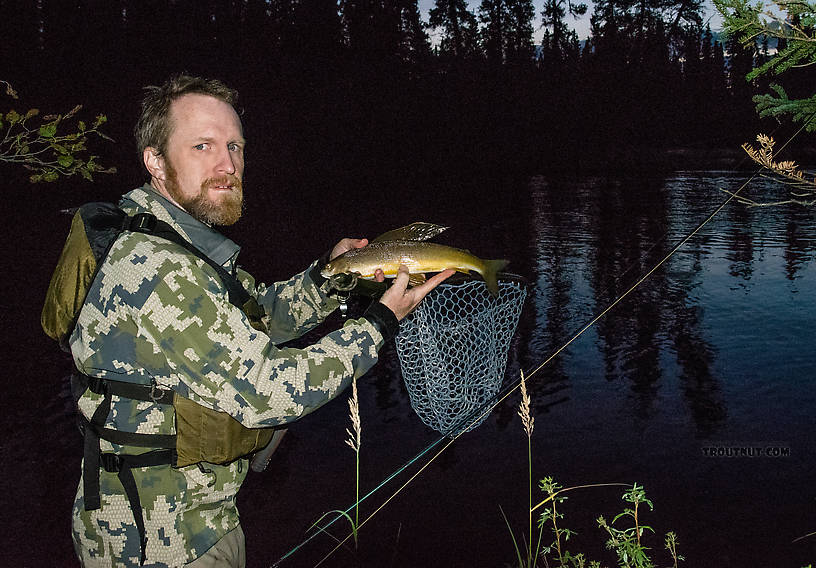
We enjoyed a satisfying meal around our friendly campfire; and just as it started to sprinkle rain, we retired to the comfort of our dry tents and warm sleeping bags for the night.
Skies were mostly clear and the sun was bright as we exited the launch area and headed down the Tanana River with the current against a mild westerly breeze.

Snow-capped peaks of the Alaska Range could be seen low on the horizon to our southeast.

The old Honda jet outboard motor expressed frequent disagreement with us about which gear it should be in, slipping from forward into neutral at the most inopportune, high-speed moments and showering Jason with cold water every few minutes. Jason navigated westward through a labyrinth of islands in the wide, shallow slurry of gray glacial melt-water. It took approximately half an hour to travel downstream to the mouth of the study stream, which was well concealed by various islands and sloughs. Within a minute, water clarity went from zero to infinity as we headed up the tributary to Jason’s study site.
In the lower couple miles we passed numerous cabins of various design, from makeshift shacks covered by rusty corrugated metal to modern log homes powered by solar energy. The only common theme among these dwellings was the obligatory pair of moose or caribou antlers adorning the front entrance, and the fact that most material had been transported here, piece by piece, after a boat ride down the Tanana. You really have to want to “get away” to maintain a residence here.
The jet motor was essential as we navigated upstream through riffles barely 6 inches deep, manually coaxing the motor to stay in gear and “up on step” through the shallows. A couple large broods of almost fully grown common mergansers calmly observed our passing from their perches atop logs lain across the surface near shore. Once we passed all the private cabins, we would search for a good site to establish base camp in the vicinity of runs or pools where Arctic grayling could be filmed and captured; but good campsites along the dense riparian corridor were few and far between.

After traveling several miles upriver and beyond the last of the cabins, I began to feel that we were burning valuable daylight. Finally we arrived at a sharp bend where the river widened considerably and the tip of the peninsula on the inside of the bend held promise as a campsite. Jason had his heart set on traveling further upstream before stopping, but I convinced him to motor to shore and have a look. With only a couple hours of daylight left, I was ready to find a reasonable place to camp.
This site turned out to be ideal. Though not used in recent years, there was a small fire ring that we later learned was made by moose hunters in seasons past. There were a couple spots high and dry enough to pitch our tents, not much brush to clear, an abundance of dead firewood, and a spectacular view of the river in a 300-degree arc around us, making it easy to spot bears that might wander too close to camp. I told Jason, “I just can’t imagine it getting any better than this, son.” Despite concerns that we might not yet be in the heart of his sampling area, Jason agreed to stop here. We tied the boat to a large spruce tree and set to work establishing base camp.
With the temperature dropping, our first order of business was to expand the fire ring and gather wood for the evening. Jason found several large rocks while I dug a deeper pit with our camp shovel. Soon we had a respectable fire pit and a crackling fire started with spruce tree sap and fueled by the abundant dead alder branches nearby. After an hour of brush and rock clearing, tents and vestibules were set up. Once our personal gear was safely under cover, we unfolded my Eno flex-fly tarp and made a secure rain shelter over a 10x10 foot area nearby where sampling gear could be stored. Large white spruce and smaller aspen or alder trees were conveniently spaced to hold the guy lines, so all we had to do was clear small brush and vegetation from the area under the tarp. Base camp was established.
It was dusk, and the sound of grayling slurping mayflies off the surface of the river was driving Jason crazy. So while I fed the campfire and made Mountain House meals, Jason assembled his fly rod and waded out from camp to drift a dry fly down a swift run before dusk yielded to dark. Before long, he had caught and released the first grayling of the trip – a plump 15-incher I photographed at 10:15 p.m.

We enjoyed a satisfying meal around our friendly campfire; and just as it started to sprinkle rain, we retired to the comfort of our dry tents and warm sleeping bags for the night.
Photos by Troutnut from the Tanana River and Mystery Creek #186 in Alaska

StateAlaska
LocationTanana River
Date TakenAug 23, 2014
Date AddedDec 19, 2014
AuthorTroutnut
CameraNIKON D5300

StateAlaska
LocationTanana River
Date TakenAug 23, 2014
Date AddedDec 19, 2014
AuthorTroutnut
CameraNIKON D5300

"Take Your Dads to Work" Day on the Chena River
Today was “Take-Your-Dads-To-Work” Day for Jason, as both Markus Vayndorf (Jason’s father-in-law) and I accompanied Jason on a day trip to the Chena River a few miles northeast of Fairbanks. We were accompanied by U.S. Fish and Wildlife Service Biologist Bill Carter, who hoped to learn enough about Jason’s underwater video techniques to employ them this fall in a study of sheefish on the Selawik River in remote northwestern Alaska.
We launched our borrowed 18-foot Jon boat off a gravel bar in the Chena River around noon and motored downstream about a mile to a large logjam where Jason had filmed juvenile Chinook salmon during his dissertation project. The salmon fry were not in typical locations, but I finally located a small group on the back side of the logjam. Markus (right) and I (left) assembled the calibration frame in the bow; then Jason readied the Go-Pro camera array as Bill (in stern) and I lowered the calibration frame into the water.
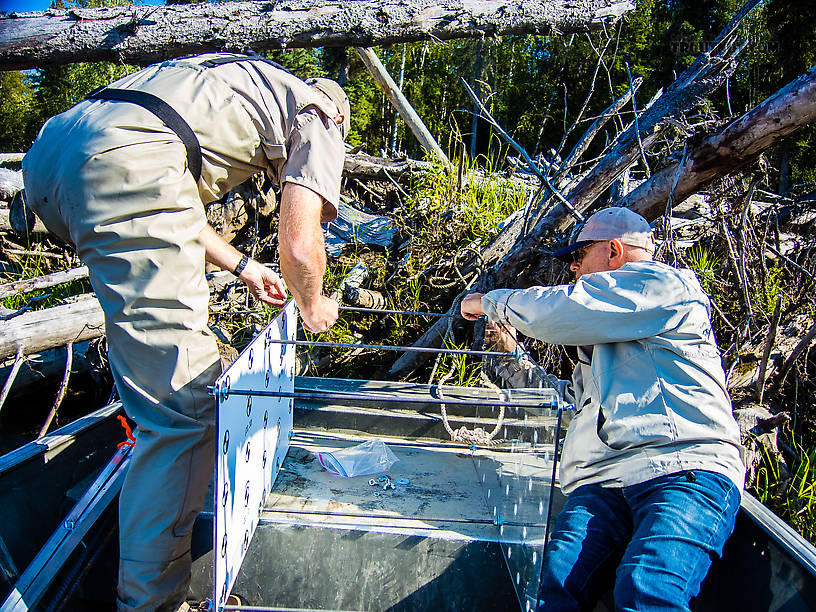
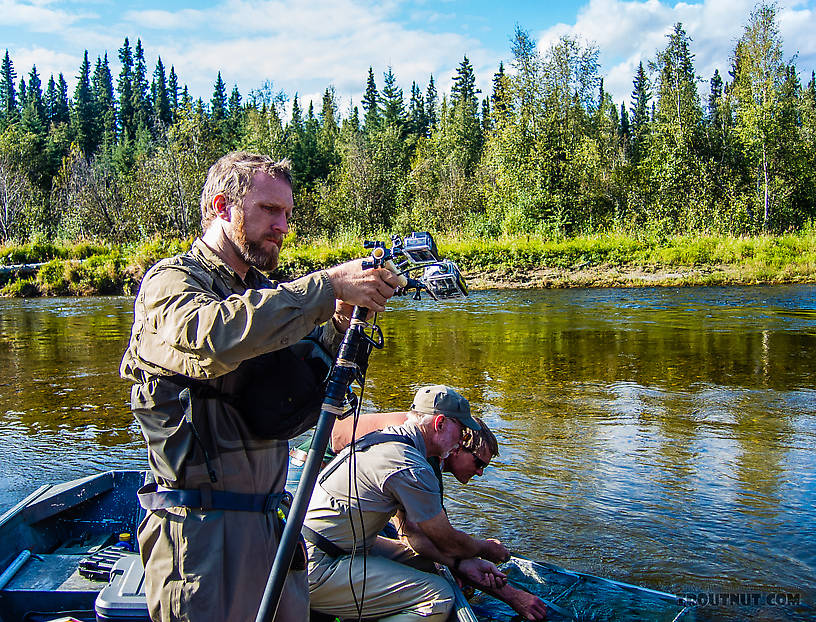
Eventually we were able to obtain some underwater video while observing the juvenile salmon with a remote monitor onboard (some of Jason’s new gadgetry). Bill learned what he needed to know. Coincidentally, Bill and his wife had attended Northland College in Ashland, Wisconsin in the late 1980s—a decade after my wife, Sandy, and I graduated from there. I enjoyed visiting with Bill about our common beginnings in the field of fisheries.
We launched our borrowed 18-foot Jon boat off a gravel bar in the Chena River around noon and motored downstream about a mile to a large logjam where Jason had filmed juvenile Chinook salmon during his dissertation project. The salmon fry were not in typical locations, but I finally located a small group on the back side of the logjam. Markus (right) and I (left) assembled the calibration frame in the bow; then Jason readied the Go-Pro camera array as Bill (in stern) and I lowered the calibration frame into the water.


Eventually we were able to obtain some underwater video while observing the juvenile salmon with a remote monitor onboard (some of Jason’s new gadgetry). Bill learned what he needed to know. Coincidentally, Bill and his wife had attended Northland College in Ashland, Wisconsin in the late 1980s—a decade after my wife, Sandy, and I graduated from there. I enjoyed visiting with Bill about our common beginnings in the field of fisheries.
Photos by Troutnut from the Chena River in Alaska
From Work to Play in One Long Day
Our ambitious plan for the day was to test Jason’s camera equipment in Mystery Creek #170, break camp and pack everything out (two one-mile round trips), then join Jason’s wife, Lena, at Denali National Park for an afternoon hike several miles up Riley Creek before rafting back down in unfamiliar whitewater and returning over 100 miles by vehicle to Fairbanks. One must try to ignore one’s actual age (59 in my case) when planning such a day. After morning coffee and granola, I prepared to break camp whenever we finish working on the creek. By mid-morning we had assembled all our gear and hauled it to a gravel bar a couple hundred yards downstream to a small pool where Jason was fairly certain there would be Dolly Varden and Arctic grayling to film. The next couple hours were spent (Spent: The wing position of many aquatic insects when they fall on the water after mating. The wings of both sides lay flat on the water. The word may be used to describe insects with their wings in that position, as well as the position itself.) calibrating and testing equipment.

We encountered several logistical and technical problems that Jason would have to address before he could reliably use the large cameras to shoot underwater video. We had hoped to film some Dolly Varden, but had to settle for discovering problems that needed solving before real data could be obtained. This is an inevitable, productive step in the first weeks of any complex new scientific research project.
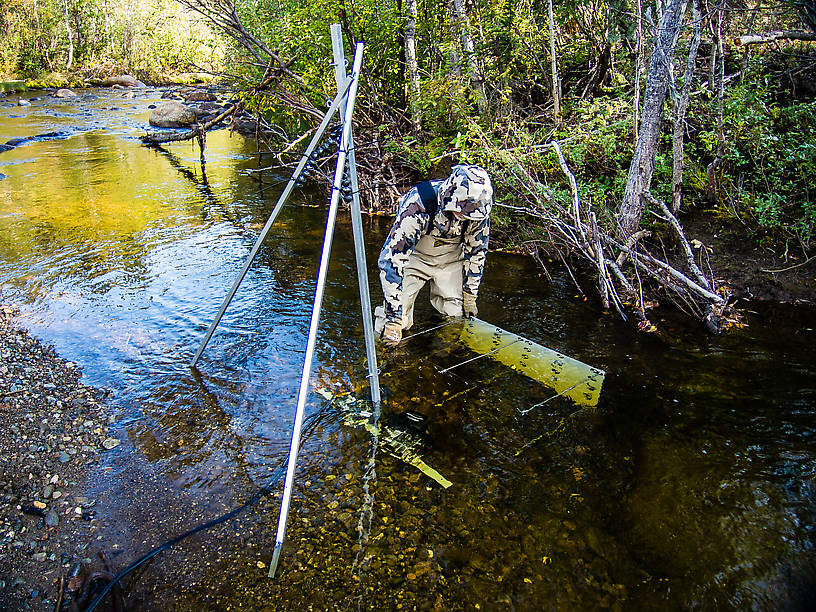
By late morning we were packing up camp and hauling all our gear back to the car. The good trail we cleared yesterday expedited our half-mile treks, but we still had to make two trips each to transport our 300+ pounds of equipment, so we did not get on the road to Denali until well after lunchtime. We met Lena at the Park Visitor Center parking lot where she had been dropped off by shuttle bus from Fairbanks. Jason and I changed clothes and gear from camping/working mode to hiking/rafting mode in the Visitor Center parking lot, much to the amusement of several fashionably dressed tourists from all over the world. By mid-afternoon we were heading up Riley Creek carrying only water, snacks, and inflatable pack rafting gear.
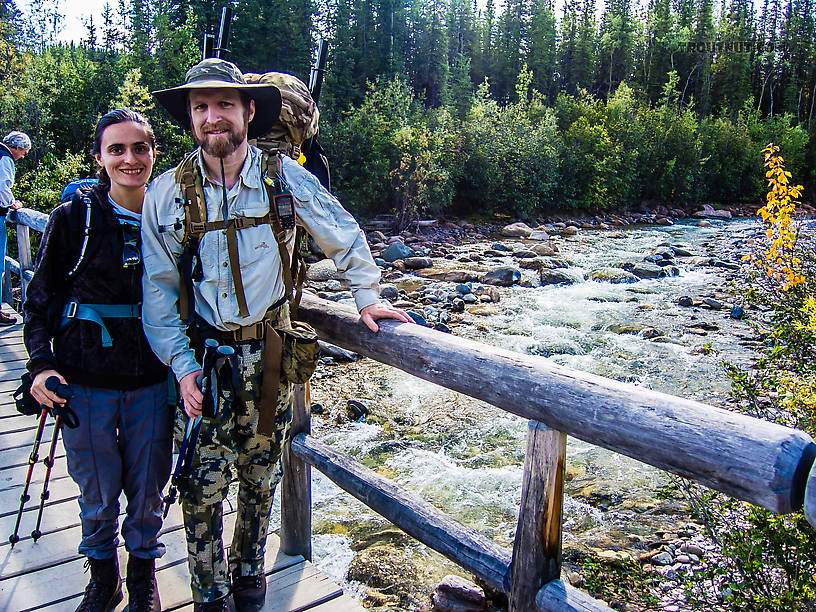
We hiked several miles upstream beyond the usual day-trip tourist area until we reached a very large, steep hill that would take at least an hour or two to circumnavigate to the planned put-in with our packrafts. Judging that we lacked the time to make the full float down, we backtracked down the hill and found a suitable spot to enter the river on a large island of gravel. Denali National Park was quite the setting for a happy couple to celebrate their 4th Wedding Anniversary. Congratulations Jason and Lena!

Near the river’s edge, we encountered three spruce grouse. Typical of their species, they were unconcerned about their safety or the closeness of our cameras.

We made our way to the gravel island, inflated the packrafts, and headed downstream at about 5:30 p.m. Pleasant runs were interspersed with challenging rapids replete with inconveniently placed boulders that required my constant attention to avoid swamping. It was an exhilarating hour of “in-the-moment” paddling that we managed to experience without serious mishap, despite several close calls.
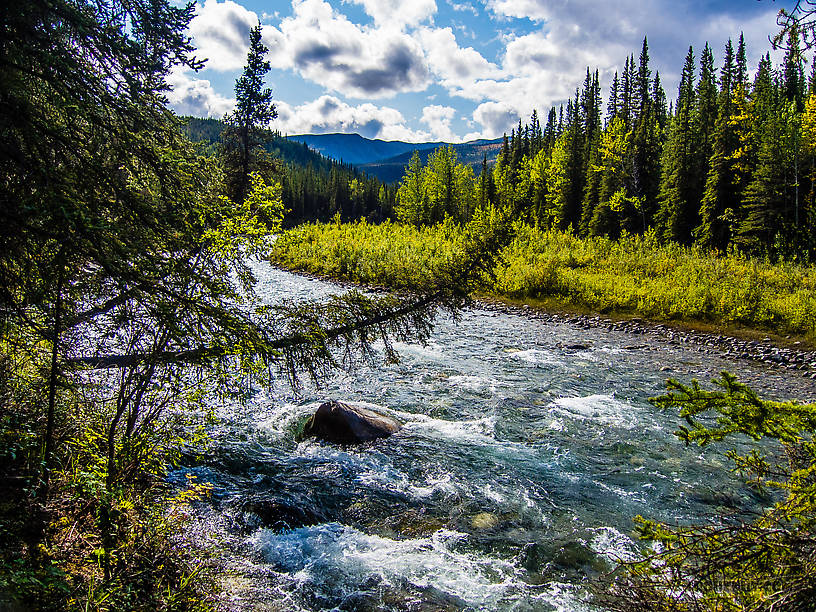
By the time we reached our take-out point on a gravel bar a couple hundred yards from the entrance road to the Park Visitor’s Center, we were soaked due to the constant splashing of large standing waves in the more turbulent rapids. Lena was getting chilly, so I agreed to stay with the equipment and deflate the rafts while Jason and Lena hitched a ride to the Visitor Center to retrieve our car. I managed to get everything hauled up to the road by the time they got back in dry clothes and a warm vehicle. We stuffed everything into the back of the RAV4 and headed back to Fairbanks as the sun was setting. What a long and exciting day!

We encountered several logistical and technical problems that Jason would have to address before he could reliably use the large cameras to shoot underwater video. We had hoped to film some Dolly Varden, but had to settle for discovering problems that needed solving before real data could be obtained. This is an inevitable, productive step in the first weeks of any complex new scientific research project.

By late morning we were packing up camp and hauling all our gear back to the car. The good trail we cleared yesterday expedited our half-mile treks, but we still had to make two trips each to transport our 300+ pounds of equipment, so we did not get on the road to Denali until well after lunchtime. We met Lena at the Park Visitor Center parking lot where she had been dropped off by shuttle bus from Fairbanks. Jason and I changed clothes and gear from camping/working mode to hiking/rafting mode in the Visitor Center parking lot, much to the amusement of several fashionably dressed tourists from all over the world. By mid-afternoon we were heading up Riley Creek carrying only water, snacks, and inflatable pack rafting gear.

We hiked several miles upstream beyond the usual day-trip tourist area until we reached a very large, steep hill that would take at least an hour or two to circumnavigate to the planned put-in with our packrafts. Judging that we lacked the time to make the full float down, we backtracked down the hill and found a suitable spot to enter the river on a large island of gravel. Denali National Park was quite the setting for a happy couple to celebrate their 4th Wedding Anniversary. Congratulations Jason and Lena!

Near the river’s edge, we encountered three spruce grouse. Typical of their species, they were unconcerned about their safety or the closeness of our cameras.

We made our way to the gravel island, inflated the packrafts, and headed downstream at about 5:30 p.m. Pleasant runs were interspersed with challenging rapids replete with inconveniently placed boulders that required my constant attention to avoid swamping. It was an exhilarating hour of “in-the-moment” paddling that we managed to experience without serious mishap, despite several close calls.

By the time we reached our take-out point on a gravel bar a couple hundred yards from the entrance road to the Park Visitor’s Center, we were soaked due to the constant splashing of large standing waves in the more turbulent rapids. Lena was getting chilly, so I agreed to stay with the equipment and deflate the rafts while Jason and Lena hitched a ride to the Visitor Center to retrieve our car. I managed to get everything hauled up to the road by the time they got back in dry clothes and a warm vehicle. We stuffed everything into the back of the RAV4 and headed back to Fairbanks as the sun was setting. What a long and exciting day!
Photos by Troutnut and Dneuswanger from Riley Creek and Mystery Creek #170 in Alaska
Top 10 Fly Hatches
Top Gift Shop Designs
Eat mayflies.
Top Insect Specimens
Miscellaneous Sites
Troutnut.com is copyright © 2004-2024 Jason
Neuswanger (email Jason). See my FAQ for information about use of my images.
 privacy policy
privacy policy

